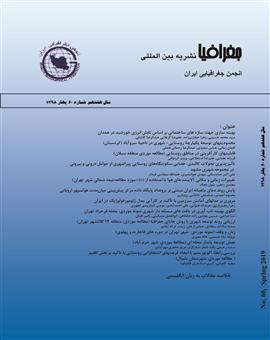ارزیابی آسیب پذیری شبکه معابر شهری در برابر زلزله های احتمالی (مطالعه موردی: منطقه 6 شهر تهران)
محورهای موضوعی :علیرضا بهرامی 1 , مهدی بهرامپور 2 , علی یزدانی 3
1 -
2 - شهر قدس
3 - رباط کریم
کلید واژه: زلزله, مدیریت بحران, روش دلفی, IHWP, GIS,
چکیده مقاله :
زلزله بشر را، درطول زمان، با خسارات جبران ناپذیری مواجه ساخته است. تصمیم گیرندگان همواره سعی در مدیریت بحران وچالش های ناشی از آن داشته اند. بنابرین ارزیابی آسیب پذیری مناطق شهری و برنامه ریزی برای کاهش این آسیب ها امری ضروری است. این پژوهش با هدف ارزیابی منطقه شهری در برابر زلزله و با رویکرد مدیریت بحران در منطقه 6 تهران انجام گردید. بدین منظور پس از بررسی های لازم 11 معیار درجه محصوریت، تراکم ساختمانی، کیفیت ابنیه، تراکم جمعیتی، مصالح واسکلت واحد ساختمانی، دسترسی به مراکز درمانی، عرض راه، ارتفاع ساختمان، کاربری زمین، بیشینه شتاب افقی زمین و قدمت ابنیه به روش دلفی ارزش گذاری شدند. بعد از آن به تحلیل شاخص ها با استفاده از مدل سلسله مراتبی معکوس IHWP پرداخته و در نرم افزار GIS، معیارها همپوشانی شدند. نتایج حاصل از نقشه آسیب پذیری منطقه به زلزله نشان داد که 4.8 درصد منطقه در کلاس آسیب پذیری خيلي كم، 19 درصد در کلاس آسیب پذیریکم، 46.2 درصد در کلاس آسیب پذیری متوسط، 25.4 درصد در کلاس آسیب پذیری امتياز زياد و 4.6 درصد در کلاس آسیب پذیری خيلي زياد قرار دارد. با توجه به نقشه آسیب پذیری منطقه 6 میتوانیم در یابیم که مناطقی که به شبکه ارتباطی با عرض بیشتر و توزیع تراکم ساختمانی کم باعث احتمال کم تخریب که اکثرا این منطقه در حاشیه منطقه و یا در شمال منطقه 6 قرار دارند. معابر موجود در شمال منطقه نسبت به بقیه محدوده مورد مطالعه دارای آسیب پذیری کمتری هستند. با حرکت از سمت شمال به جنوب منطقه، بر میزان آسیب پذیری افزوده میشود.
Human earthquake, over time, faced with irreparable damages. Decision-makers have always tried to manage the crisis and challenges arising from it. Therefore, assessment of vulnerability of urban areas and planning to reduce these damage is necessary. This research was conducted with the aim of assessing the urban area against earthquake and with the crisis management approach in Tehran 6th area. For this purpose Valued, 11 criteria for degree of confinement, construction density, building quality, population density, materials and structure of the building unit, access to health centers, width of the road, building height, land use, maximum horizontal acceleration of the land and the age of the building by Delphi method. Subsequently, the indexes were analyzed using the IHWP Hierarchical Model and the criteria were overlapped in GIS software. The results of the earthquake vulnerability map showed 4.8% of the area in the vulnerability class was very low, 19% in the vulnerability class, 46.2% in the middle class vulnerability, 25.4% in the vulnerability class, and 4.6% in the vulnerability class. The vulnerability class is very large. Regarding the Vulnerability Map of Area 6, we can find that areas with a higher-wiring network and low-density distribution of low-density constructions tend to be less damaged, most of which are located on the periphery of the region or north of the 6th area. Existing districts in the north of the region are less vulnerable than the rest of the study area. As you move from north to south, the vulnerability increases.
